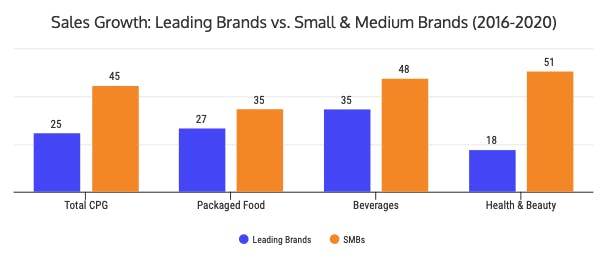Small brands, you’re in demand – at home and around the world. E-commerce is amplifying the Small is Big trend, helping small consumer packaged goods (CPG) brands drive revenue growth and influence global consumption. According to IRI, the pandemic propelled U.S. consumers toward smaller CPG manufacturers. As bigger brands struggled to meet demand, many shoppers chose smaller brands, which accounted for about one-third of the 10.3% CPG sales growth in 2020.1 De Socio, Mike. Big Food lost $12B in sales to small CPGs and private label in 2020, IRI says. Food Dive. February 4, 2021.
The following graph of Nielsen data reinforces U.S. small brands’ momentum in outperforming leading brands in competitive CPG categories.2 Kopka, Udo, Eldon Little, Jessica Moulton, René Schmutzler, and Patrick Simon. What got us here won’t get us there: A new model for the consumer goods industry. McKinsey & Company. July 30, 2020.

Amid surging popularity, small brands are embracing e-commerce as their first step to connect with global consumers and retail buyers to fuel growth. E-commerce democratizes retail, which helps brands like yours reach global markets with ease, so you can sell wherever your products are in demand.
Small brands have an enviable edge in agility and speed-to-market. While larger suppliers often rework their legacy systems to adapt to consumer demand, smaller suppliers like you can pounce on emerging trends and gain a first-mover advantage. Popular global consumer trends include sustainability, purpose-led brands, and health and wellness, including plant-based foods.
Why limit yourself?
If your products align with these mega-trends, you could be in-demand beyond the domestic border. Selling online could boost your 2021 sales by serving common needs among consumers around the world. For instance, similar to North American shoppers, European consumers crave greater variety, value, and healthy CPG options.3 Spencer-Jolliffe, Natasha. How to predict trends in a pandemic. Speciality Food. April 19, 2021.
The most agile, customer-centric brands will triumph online.
The booming e-commerce space efficiently connects brands with global shoppers. Last year, worldwide retail e-commerce sales grew more than 27%, accounting for $4.28 trillion. Latin America earned nearly 37% e-commerce growth, with Argentina rising a whopping 79%.4 Cramer-Flood, Ethan. Global Ecommerce Update 2021. eMarketer. January 13, 2021. As online shopping rises globally, you could improve your top line by selling next door in Canada and Mexico or further away in New Zealand and Australia.
E-commerce has low barriers to entry, making it easy for small brands to gain limitless reach, given the international nature of the Internet. Also, your merchandise is no longer constrained to only two feet of brick-and-mortar shelf space thanks to the endless aisle of your digital shelf.
Brands’ e-commerce alternatives
To reach consumers around the world, brands now choose among the following distribution channels.
- Direct-to-consumer (DTC): More CPG brands are skipping retailers and selling their products directly to shoppers through their own e-commerce websites. Brands gain control over their merchandising, and pricing, yet distribution and marketing acquisition costs could be steep.
- Online marketplaces: Synonymous with e-commerce, Amazon has more than 1.9 million small- and medium-sized businesses selling on its third-party marketplace to more than 200 million Prime members worldwide.5 Read Amazon CEO Jeff Bezos’s Letter to Shareholders. The Wall Street Journal. April 15, 2021. Brands can opt to access logistics expertise through Fulfillment by Amazon. Etsyis another marketplace that attracts small brands, especially sellers of one-of-a-kind artisan goods.
- Retailers that ship internationally: To align with global omnichannel trends, more retailers partner with logistics experts to ship brands’ products internationally. For instance, Walgreens’ online store uses package forwarding company Planet Express and Sephora partners with global e-commerce provider Borderfree.
- Social media: Platforms like TikTok, Facebook, Instagram, and Pinterest are adding new e-commerce functionality to sell to consumers where they already socialize online. Small brands can showcase their products to global consumers as these platforms evolve.
E-commerce trends influence business strategies
As you consider how e-commerce could help you grow, keep in mind the following e–commerce trends affecting brands and retailers.
- Online is getting busier: As more consumers and companies migrate to e-commerce, brand rivalry is heating up. Brands need to consider which platforms are best for their business models to maximize online sales. The best practices coming up in the next section recommend ways to compete effectively online.
Small businesses in grocery, health and fitness are emerging as e-commerce winners.6Halmeri, Amy. When You’re a Small Business, E-Commerce Is Tougher Than It Looks. The New York Times. March 7, 2021.
- Consumers shape assortments: Brands can captivate consumers and retail buyers by emphasizing how their products are consumer-centric. Distinguish your brand by reflecting shoppers’ values and lifestyles through certifications, such as organic, vegan, keto and hypoallergenic products. Align with retailers’ corporate social responsibility initiatives like celebrating consumer diversity and innovating with sustainability.
- Trust wins sales: Since online shoppers and retail buyers can’t immediately touch, taste, or test your products, use digital content to convey sensory information to inspire consumer confidence in your brand. Sharing accurate product data and images, relevant certifications, reviews, user-generated content and a hassle-free return policy boost credibility. Telling your origin story and showing the people behind your products also demonstrates authenticity and transparency.
E-commerce best practices boost your brand power
These proven practices can help your brand prepare for global online growth.
1. Consumer analysis
Learn what products your target consumers currently use and compare your goods’ features and benefits. Research different jurisdictions to spot where your products can win by aligning with 2021’s hottest product trends, plus underserved niches. Regional trends can also help localize your marketing to resonate and sell more to consumers.
2. Competitive analysis
E-commerce boosts competition, so know which global rivals need to be on your radar, as their items represent potential substitutes to your products. Study their ranges to know what makes your products unique. Determine how your pricing can help you compete as more global consumers search online for value and premium products. Also, plan how you can collaborate with supply chain partners to scale fast if your online sales surge.
3. Digital marketing
Online marketing and communities have stretched consumer trends across borders. Stand out by aligning your marketing with global product trends like vegan and hypoallergenic. Emphasize how your company is unique, such as woman-owned, ethnic minority-owned or veteran-owned. Share timely data and high-quality images on product description pages, keywords and ad campaigns. Whatever e-commerce platform you choose, understand how its algorithm affects your online visibility and brand reach.
Boldly go where no brand has gone before
To seize upon small brands’ popularity, consider e-commerce as your best first step to connect your products with consumers and retailers around the world. E-commerce levels the playing field for brands of all sizes to sell to global markets and grow in 2021. Instead of wondering why you should sell your products to eager shoppers in Dublin, Vancouver, or Sydney, the question is now, “Why not?”
Stay tuned for an upcoming post on 2021 global CPG trends sparking small brands’ success.

